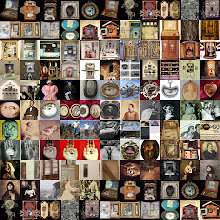
When visiting the retrospective of Gauguin at the Tate Modern, I found a very interesting sculpture called Oviri that represents a form of primordial feminine force, an aggressive Goddess. Oviri means 'savage' in tahitian language, and Gauguin used this word to name a female figure that fascinated him, he did several woodcuts on the theme and considered it his best ceramic asking for it to be placed at his tomb. It is unclear wether he was inspired by original Tahitian myths or created and named such a Goddess himself, but this is not of so much importance. What I found really intriguing about this sculpture, specially in relationship to the whole exhibition, was Gauguin's exploration of myth and his representation of the female. The nude women in his works correspond to ideas of feminitity, "cultural arquetypes correlated with his attraction to the Romantic myth of the 'Eternal Femenine' , much invoked by symbolist artists and writers of the period, whereby a woman was an instinctual or spiritual being, wether a wicked temptress or a saintly virgin." (quote taken from Tate Modern website)
However Oviri departs from the virgin/temptress dichotomy, and seems to hint to a natural female force that surpasses the stereotypes of the time, based on the two feminine icons: Eve the sinner and the saintly Virgin Mary. Gauguin, in his unique position as artist and explorer of myth and living in exotic Tahiti, has digged into ideas of the wild, the savage and the primitive. Looking to explore a pagan culture, he was terribly disappointed when he discovered that missionaries had been converting the islanders for more than a century. This did not stop him from exploring ideas of the pagan-primitive from his western standpoint. He successfully shapes a female force, an arquetype, we can recognise in the collective unconscious, that of the primordial female creator. He described her as "monstrous and majestic, drunk with pride, rage and sorrow." Note the reference to deep emotional power and expression, and the contradictory monstrous, majestic and prideful, conveying what is powerful beyond control. This female God is irrational and violent, unlike the rational judge male version of God invented by a male dominant society, ultimate rational explanator and definer. This female God cries and rages, as a menstruating woman would.
And at the back of the sculpture, between the waves of long untammed hair emerge two foldings at the sides of a giant crack. And then I comprehend that it is a vaginal opening: primordial creator of all.
The mention of the menstruating woman results from reading The Wise Wound, a book by Penelope Shuttle and Peter Redgrove (first published 1999) which explores cultural, social and psychological dimensions of the menstrual cycle. The book associates the menstruating woman with the cursed Eve and a neglected active and powerful female sexuality, whilst associating the ovulating biological and psychological reality to cultural notions of the traditional female role as mother and submissive wife. In the light of this book, Oviri would no doubt be the rationally uncontrolled, emotionally and earthly rooted feminine force. Furthermore linking the deep associations of (menstrual)blood to violence, life and death, Gauguin's menstrual Goddess would be strangling the wolf cub she bears in her blood stained hands, to symbolise her blood-power to decide upon life and death. The female power to sacrifice every month (the blood, the unborn), death inexorably linked to her power to create life. Oviri is hence the God, the Creator, and a feminine one, for it is in the nature of she to sacrifice and create every month, and to give birth, to create.
After all this realisation while I was visiting the exhibition (and currently reading The Wise Wound), I eagerly looked for the catalogue of the exhibition in the bookshop, looking forward to reading with passionate enjoyment more about the female God and her giant vagina, when I found the text about Oviri and to my complete horror, shock, anger and dismay (and that was, without even being menstruating) it described it as having a "phallic nature"! I read the passage at least three times to make sure I was making sense of what I was reading, and yes, it did say the Goddess, with those protruding giant vaginal labia, was of "phallic nature". Anything but phallic, for Goddess' sake!!
NOTE: It proved very difficult to find an image on the internet of the vagina-shaped back of the sculpture, with which to illustrate my point, which in actual fact further demonstrates the social and cultural neglect towards an active powerful femininity, (and the vagina). Regarding the drawing, I didn't draw in detail the wolf cub she is clasping. In Paul Gauguin's article in the wikipedia Oviri's "phallic" nature is further stated.



